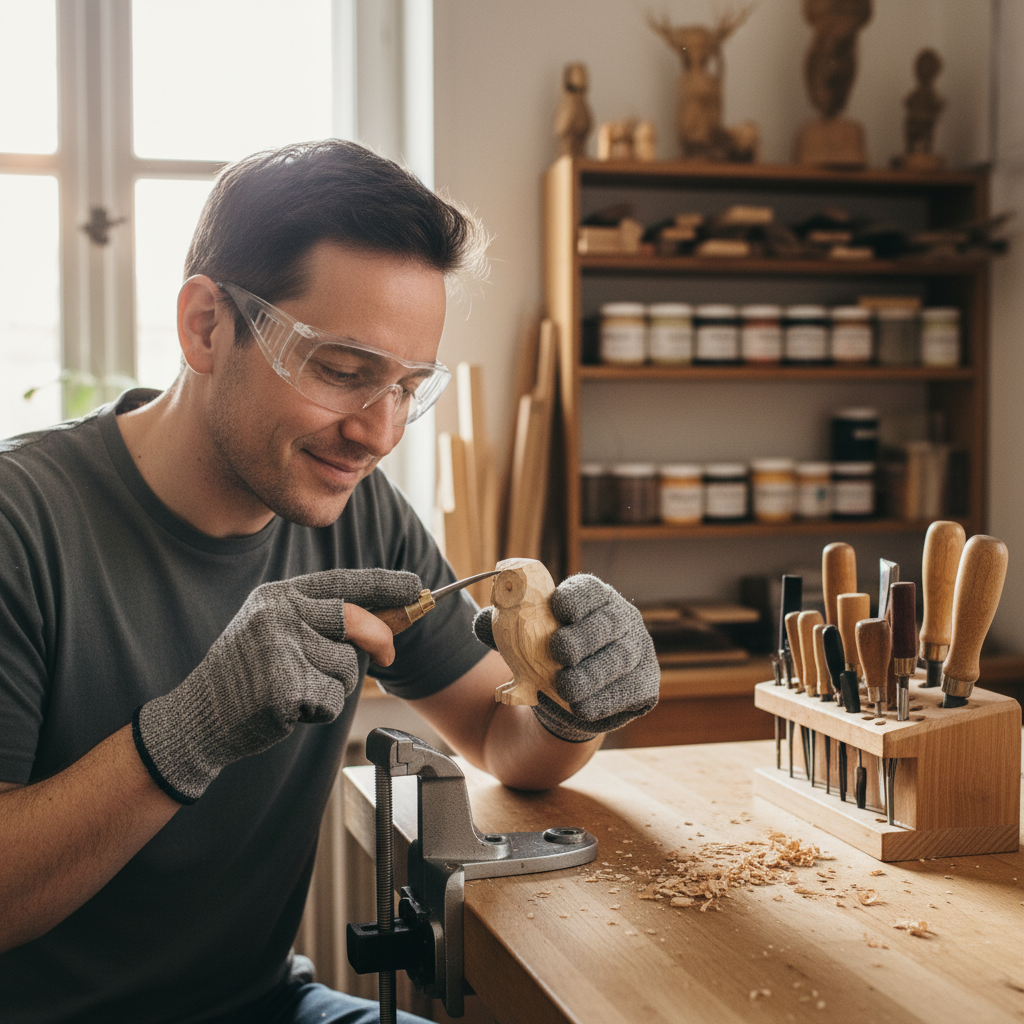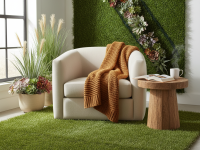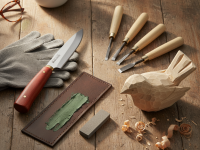Hey there, aspiring wood carver! Are you feeling that exciting pull to transform a simple block of wood into something beautiful, something uniquely yours? That’s the magic of wood carving, and it’s a truly rewarding journey. But before you dive in, let’s have a candid chat about something absolutely non-negotiable: safety.
I get it. When you’re just starting out, the allure is all about the tools and the creative process. You’re dreaming of intricate details and smooth curves. But trust me, as someone who’s spent countless hours with carving knives and gouges, the foundation of any enjoyable carving experience isn’t just skill – it’s safety.
I remember my own early days. Full of enthusiasm, a little bit clumsy, and perhaps a touch overconfident. I quickly learned that wood carving tools are wonderfully precise, but they’re also incredibly sharp. A moment’s lapse in judgment or an unexpected slip can turn a relaxing hobby into a trip to the emergency room. My goal with this article is to share my experience and guide you through the essential safety gear you absolutely need, so you can carve confidently, avoid those begier mishaps, and truly enjoy every minute of your creative process.
Why Safety First Isn’t Just a Slogan, It’s Your Mantra
You might be thinking, “Do I really need all that gear just to whittle a small piece of wood?” And my emphatic answer is: Yes, you do! Wood carving, at its core, involves manipulating sharp objects near your body, often with a fair bit of force. The risks aren’t just minor nicks; we’re talking about deep cuts, punctures, splinters flying into eyes, and even tendon damage.
In my early years, I saw a fellow carver make a simple mistake – he wasn’t wearing eye protection, and a tiny chip of wood ricocheted directly towards his face. Thankfully, it only hit his cheek, but it was a stark reminder of how quickly an accident can happen. This isn’t about scaring you; it’s about empowering you with knowledge and the right equipment to protect yourself. Think of safety gear not as a hindrance, but as your silent partner, allowing you to focus purely on your artistry without worrying about potential injuries.
Your First Line of Defense: Hand Protection
When you’re carving, one hand holds the wood, and the other wields the tool. It’s the hand holding the wood that’s most often in harm’s way, especially when you’re pushing a knife or gouge towards it. This is where cut-resistant gloves become your best friend.
Cut-Resistant Gloves
- What They Are: These aren’t your average gardening gloves. They’re typically made from high-strength materials like Kevlar, Dyneema, or other synthetic fibers designed to resist cuts from sharp blades. They come with various cut-resistance ratings (often EN388 or ANSI ratings), so look for something with a decent level of protection.
- Why They’re Crucial: Your non-carving hand is your anchor. It holds the piece, often providing leverage or simply keeping the wood stable. A slip of the carving tool, especially when working on a tricky angle or pushing through tough grain, can easily send the blade directly into your supporting hand. A good cut-resistant glove can prevent a serious injury, turning what could have been a deep gash into a mere glancing blow.
- My Experience: I remember trying to carve a small owl when I first started. I was holding the tiny head firmly, pushing a gouge with my other hand. The wood suddenly gave way, and the gouge slipped! Thankfully, I had already invested in a single cut-resistant glove for my non-carving hand. The blade bit into the glove, but my skin was perfectly fine. That moment cemented my belief: never carve without it.
- Tips for Choosing: You usually only need one glove for your non-dominant, wood-holding hand. Look for a glove that fits snugly but still allows for good dexterity. You need to feel the wood! Some carvers prefer a full glove, while others might opt for a fingerless design with reinforced palms.
Guard Your Vision: Eye Protection is Non-Negotiable
Just like hand protection, eye protection is not optional. Think about it: you’re creating wood chips, dust, and sometimes even small splinters. All it takes is one tiny piece flying off at speed to cause irreversible damage to your eyes.
Safety Glasses or Goggles
- The Risks: Whether you’re making a rough cut or a fine detail, tiny wood particles can become airborne. If you’re using power tools alongside hand tools (like a Dremel for sanding or detailing), the risk increases exponentially.
- My Experience: I once saw a seasoned carver working on a larger piece with a mallet and chisel. A particularly stubborn chip broke free with more force than expected, flying directly at his face. His safety glasses, which he wore out of habit, absorbed the impact. He just calmly continued, but the sound of that chip hitting the plastic was a vivid reminder of how crucial that barrier is. Don’t rely on luck!
- What to Look For: Ensure your safety glasses meet the ANSI Z87.1 standard. This certification means they’ve been tested for impact resistance. Look for glasses with side shields for comprehensive protection. If you wear prescription glasses, you can get safety glasses that fit comfortably over them, or invest in prescription safety glasses.
- Comfort is Key: You’re more likely to wear them if they’re comfortable. Look for lightweight, anti-fog options.
Stable Ground: The Importance of a Secure Workstation
While not “gear” you wear, a safe and secure workstation is paramount to preventing accidents. A wobbly piece of wood is an invitation for tools to slip and stray.
Bench Vise or Clamps
- Why They’re Crucial: Trying to hold your carving project firmly with one hand while manipulating a sharp tool with the other is incredibly risky. A bench vise or a set of reliable clamps secures your workpiece, freeing up both your hands to control the carving tool. This gives you much better leverage, precision, and significantly reduces the chance of the wood slipping or twisting unexpectedly.
- My Experience: Early on, I tried to carve a small figure while just holding it in my lap. It kept shifting, and I found myself struggling to apply consistent pressure. Not only was the carving difficult, but I realized how dangerous it was – my hands were too close to the blade, and control was compromised. Investing in a small carving vise or even just a few C-clamps made a world of difference. It’s like having an extra pair of incredibly strong, steady hands.
- Tips: For smaller projects, a bench hook or a simple non-slip mat can also help, but clamps offer superior stability. Ensure your clamps have protective pads to avoid marring your wood.
Good Lighting
- Why It Matters: You can’t carve safely if you can’t see what you’re doing. Poor lighting strains your eyes, makes it hard to see grain direction, and increases the likelihood of making a mistake.
- My Experience: I once tried to finish a detail late in the evening under dim ambient light. I completely misjudged the depth of a cut, leaving a small divot I hadn’t intended. If I had simply turned on my task lamp, I would have seen the subtle shadow and avoided the error. Good lighting reduces fatigue and makes details pop, allowing for safer, more accurate work.
Beyond the Basics: Good Practices and Other Gear
While gloves and eye protection are your absolute must-haves, there are a few other considerations and practices that will further enhance your safety and enjoyment.
First Aid Kit
Even with all the precautions, minor nicks can happen. It’s not a sign of failure, just a reality of working with sharp tools. Always have a well-stocked first aid kit within easy reach. It should contain bandages, antiseptic wipes, medical tape, and perhaps some sterile gauze. Trust me, you’ll be glad it’s there for those inevitable small slips.
Proper Sharpening
This might sound counterintuitive, but a sharp tool is a safe tool. A dull blade requires more force to make a cut. When you’re pushing harder, there’s a greater chance of the tool slipping, and when it does, it can cause a more serious injury. A sharp blade, on the other hand, glides through the wood with minimal effort, giving you more control and predictability. Learning to properly sharpen your tools is a fundamental carving skill and a crucial safety measure.
Correct Carving Techniques
No amount of gear can replace good technique. Always carve away from your body. Use controlled cuts, not forced jabs. Understand the grain of the wood – carving against it can lead to unexpected slips. And if you’re ever unsure about a cut, stop, reposition yourself or your workpiece, and re-evaluate. Taking a moment to think is always better than rushing into a dangerous situation.
Take Breaks
Carving is meditative, but it can also be physically and mentally tiring. Fatigue leads to a loss of focus and control, increasing the risk of accidents. Step back, stretch, refresh your mind and eyes every hour or so. Your hands and your eyes will thank you, and your carving will likely improve too!
Conclusion
So there you have it – the essential safety gear and practices that will transform your begier wood carving experience from potentially precarious to consistently confident. Wood carving is a beautiful art form, a way to coect with nature and unleash your creativity. Don’t let fear of injury hold you back. Instead, embrace these safety essentials as part of your carving ritual.
Your hands, your eyes, your peace of mind – they are worth protecting. Equip yourself wisely, learn the ropes, and then let your creativity flow freely. Happy carving, and more importantly, safe carving!




